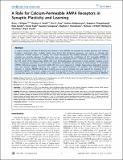| dc.contributor.author | Tonegawa, Susumu | |
| dc.contributor.author | Wiltgen, Brian J. | |
| dc.contributor.author | Royle, Gordon A. | |
| dc.contributor.author | Gray, Erin E. | |
| dc.contributor.author | Abdipranoto, Andrea | |
| dc.contributor.author | Thangthaeng, Nopporn | |
| dc.contributor.author | Jacobs, Nate | |
| dc.contributor.author | Saab, Faysal | |
| dc.contributor.author | Heinemann, Stephen F. | |
| dc.contributor.author | O'Dell, Thomas J. | |
| dc.contributor.author | Fanselow, Michael S. | |
| dc.contributor.author | Vissel, Bryce | |
| dc.date.accessioned | 2011-01-06T16:34:41Z | |
| dc.date.available | 2011-01-06T16:34:41Z | |
| dc.date.issued | 2010-09 | |
| dc.date.submitted | 2010-05 | |
| dc.identifier.issn | 1932-6203 | |
| dc.identifier.uri | http://hdl.handle.net/1721.1/60383 | |
| dc.description.abstract | A central concept in the field of learning and memory is that NMDARs are essential for synaptic plasticity and memory formation. Surprisingly then, multiple studies have found that behavioral experience can reduce or eliminate the contribution of these receptors to learning. The cellular mechanisms that mediate learning in the absence of NMDAR activation are currently unknown. To address this issue, we examined the contribution of Ca[superscript 2+]-permeable AMPARs to learning and plasticity in the hippocampus. Mutant mice were engineered with a conditional genetic deletion of GluR2 in the CA1 region of the hippocampus (GluR2-cKO mice). Electrophysiology experiments in these animals revealed a novel form of long-term potentiation (LTP) that was independent of NMDARs and mediated by GluR2-lacking Ca2+-permeable AMPARs. Behavioral analyses found that GluR2-cKO mice were impaired on multiple hippocampus-dependent learning tasks that required NMDAR activation. This suggests that AMPAR-mediated LTP interferes with NMDAR-dependent plasticity. In contrast, NMDAR-independent learning was normal in knockout mice and required the activation of Ca[superscript 2+]-permeable AMPARs. These results suggest that GluR2-lacking AMPARs play a functional and previously unidentified role in learning; they appear to mediate changes in synaptic strength that occur after plasticity has been established by NMDARs. | en_US |
| dc.description.sponsorship | National Health and Medical Research Council (Australia) (Grant number 188819) | en_US |
| dc.description.sponsorship | National Institute of Mental Health (U.S.) (grant P50-MH58880) | en_US |
| dc.description.sponsorship | National Science Foundation (U.S.) (grant number 0543651) | en_US |
| dc.description.sponsorship | National Institute of Mental Health (U.S.) (grant number MH609197) | en_US |
| dc.description.sponsorship | National Institute of Mental Health (U.S.) (MH62122) | en_US |
| dc.language.iso | en_US | |
| dc.publisher | Public Library of Science | en_US |
| dc.relation.isversionof | http://dx.doi.org/10.1371/journal.pone.0012818 | en_US |
| dc.rights | Creative Commons Attribution | en_US |
| dc.rights.uri | http://creativecommons.org/licenses/by/2.5/ | en_US |
| dc.source | PLoS | en_US |
| dc.title | A Role for Calcium-Permeable AMPA Receptors in Synaptic Plasticity and Learning | en_US |
| dc.type | Article | en_US |
| dc.identifier.citation | Wiltgen, Brian J. et al. “A Role for Calcium-Permeable AMPA Receptors in Synaptic Plasticity and Learning.” PLoS ONE 5.9 (2010): e12818. | en_US |
| dc.contributor.department | Massachusetts Institute of Technology. Department of Biology | en_US |
| dc.contributor.department | Picower Institute for Learning and Memory | en_US |
| dc.contributor.approver | Tonegawa, Susumu | |
| dc.contributor.mitauthor | Tonegawa, Susumu | |
| dc.relation.journal | PLoS ONE | en_US |
| dc.eprint.version | Final published version | en_US |
| dc.type.uri | http://purl.org/eprint/type/JournalArticle | en_US |
| eprint.status | http://purl.org/eprint/status/PeerReviewed | en_US |
| dspace.orderedauthors | Wiltgen, Brian J.; Royle, Gordon A.; Gray, Erin E.; Abdipranoto, Andrea; Thangthaeng, Nopporn; Jacobs, Nate; Saab, Faysal; Tonegawa, Susumu; Heinemann, Stephen F.; O'Dell, Thomas J.; Fanselow, Michael S.; Vissel, Bryce | en |
| dc.identifier.orcid | https://orcid.org/0000-0003-2839-8228 | |
| mit.license | PUBLISHER_CC | en_US |
| mit.metadata.status | Complete | |
